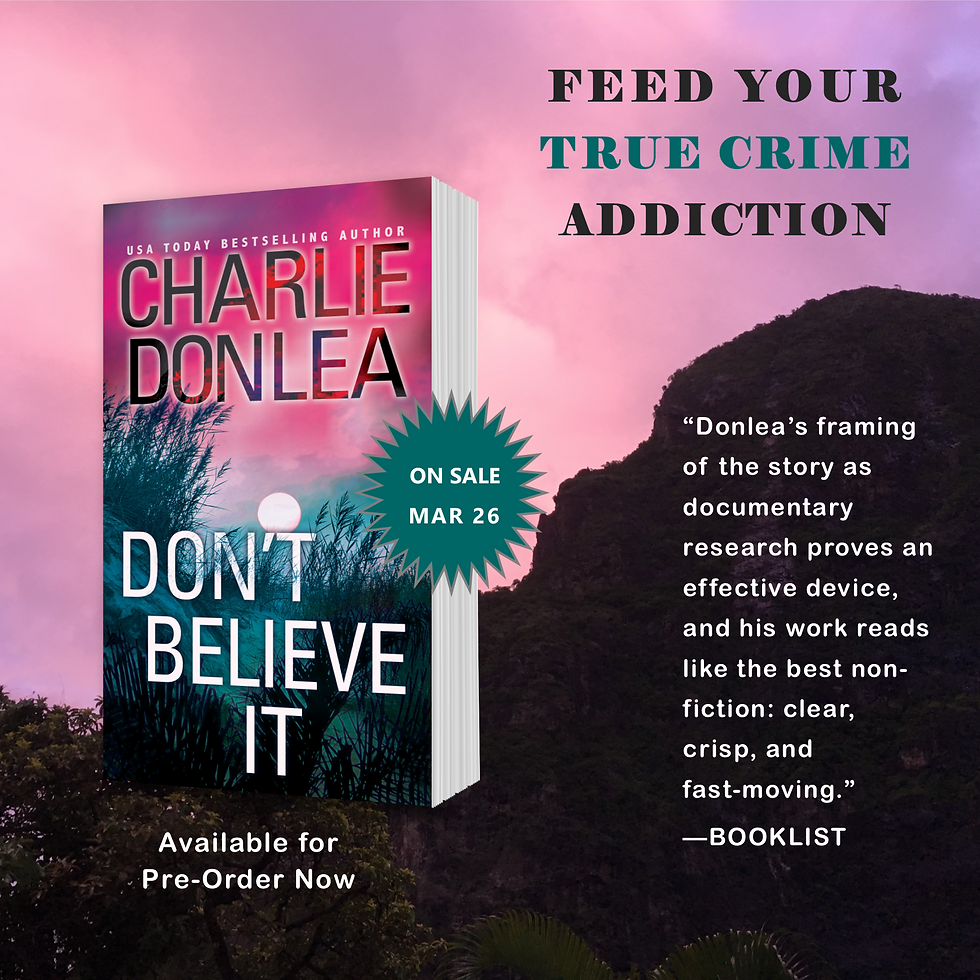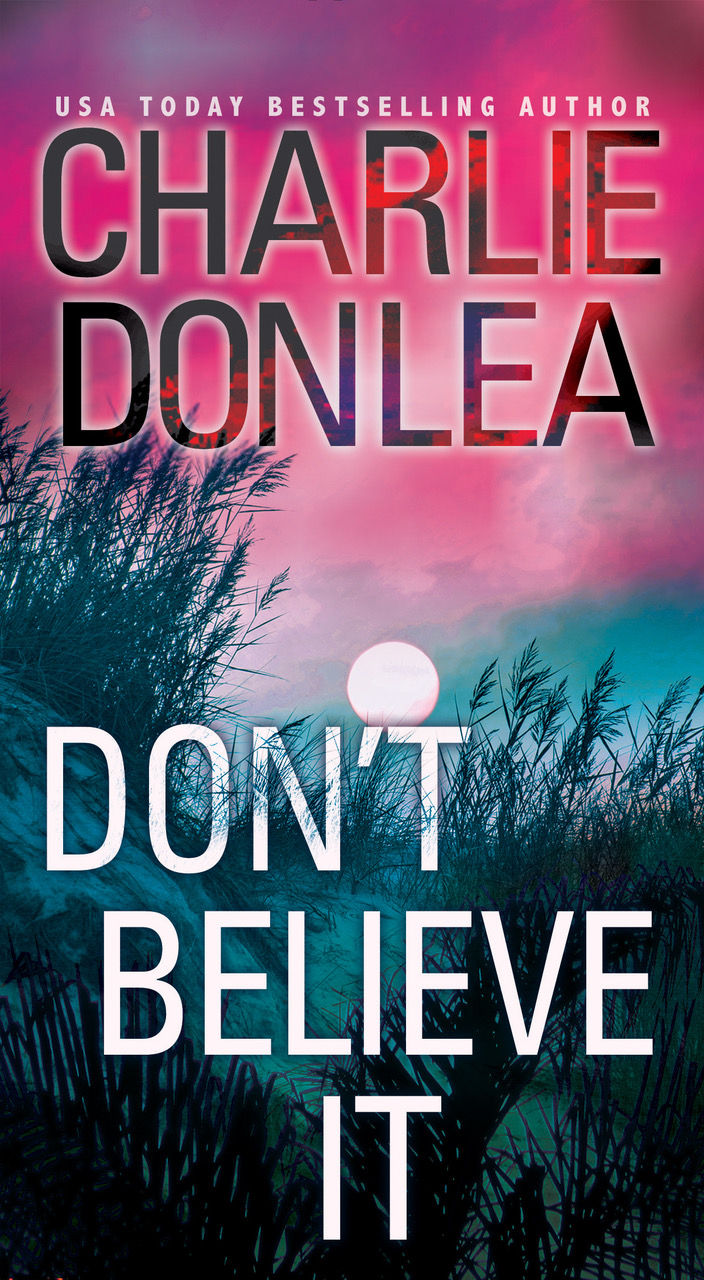THE TRUE-CRIME ADDICTION
- Charlie Donlea

- Mar 22, 2019
- 6 min read
To celebrate the paperback release of Don’t Believe It, which follows a true-crime documentary filmmaker as she hunts for answers to a decade-old murder, I thought I’d highlight the documentaries that inspired the story.

“Charlie Donlea’s best book yet!” —Mary Kubica, NYT bestselling author of The Good Girl and When the Lights Go Out.
Serial and Making a Murderer have each been credited with fueling the true-crime craze.
Serial stands as one of the most popular podcasts in history, with over 175 million listeners downloading the first season. Making a Murderer drew an audience of 20 million viewers. But before these two landmark series, Dateline and 48 Hours have been offering true-crime mysteries for decades in short, addictive, hour-long episodes. The Jinx, The Keepers, S-Town, Dirty John, and Up and Vanished are just a few examples of other real-life stories that have been serialized for mass consumption.
The Internet is filled with articles about why true-crime is so big, and whether this worldwide obsession with the morbid details of these cases is healthy or a sign of darker times.
I’ll leave it to others to decide if turning real-life crime into pop culture makes our society perverted, voyeuristic, or more dangerous. I write thrillers. I’m proud to label my stories as escapism. My goal has always been to transport readers to a different world by providing a portal away from reality. If they climb through this portal on a beach and call my novel a beach read, even better. I think Don’t Believe It accomplishes that goal.
To give readers an idea of the stories that inspired the novel, I've outline four documentaries that spurred the idea behind Don’t Believe It. These include Serial, Making a Murderer, The Jinx, and The Staircase.
I wanted to capture the most addictive aspects of each production to make sure I incorporated them, in some form, into Don’t Believe It. Picking the documentaries apart, I came up with four elements each production possessed that drew me to the story and had me hooked:
1. the crime was grisly.
2. the accused seemed innocent.
Or, at least, parts of their stories made it hard to believe they were guilty.
3. the accused was unique
(and sometimes, outright bizarre)
4. the storytelling technique was innovative
*Spoilers follow, so beware.
Serial drew millions of listeners because of the distinctive way in which Sarah Koenig produced the episodes – in real time, dropping a new episode each week that revealed the latest discoveries of her investigation.
Podcast listeners learned what the investigator was learning, at nearly the same time she was learning it. It was ingenious, groundbreaking and made for perfect water cooler discussions. Word of mouth spread and the audience ballooned to epic proportions. But if Serial had tried this concept on a ho-hum crime, despite the unique method of storytelling, it might not have found the same popularity. What pushed it over the top was the idea that the man accused of killing the nineteen year old high school senior named Hae Min Lee might actually be innocent. The lure of the podcast was that the real-time investigation would attempt to prove if he did or didn’t kill her. The crime, sadly, was grisly. Hae Min Lee was strangled and her body hidden and partially buried in a wooded area. The subject at the center of the documentary was Adnan Syed, who tells his story through the static of recorded calls from prison in a calm, articulate voice that made many listeners, myself included, wonder if a young man this intelligent and adamant about his innocence could really be guilty.
Making a Murderer had, at its core, Steven Avery, a man who had served eighteen years in jail for a crime he did not commit.
He was exonerated through DNA evidence. A mere two years after his release, he was arrested for the brutal death of Teresa Halbach, whose charred remains were found in a fire pit on Avery’s property. The combination of an interesting suspect, a grisly crime, and the suggestion of planted evidence made viewers question whether Avery was guilty or innocent. Add to this the fact that the documentary was shot over a ten-year period, and it’s not hard to see why twenty million people were addicted to the series.
The Jinx featured the ultra-bizarre story of Robert Durst, a member of the wealthy New York real estate family.
He was suspected of killing his wife in 1982, went into hiding in Texas, and killed his neighbor while on the lam. Although he was convicted of dismembering his housemate, he was acquitted of the murder. Robert Durst was the definition of unique, and the did-he-or-didn’t-he question ran solidly though the documentary ultimately focused on the disappearance of his wife. The film ended, after some great investigational work by Andrew Jarecki and his team of producers, with what appeared to be Durst confessing to killing his wife. The final episode showcasing the production crew’s plan to present their damning evidence and trap the wildly unpredictable killer was downright fascinating.
Finally, The Staircase tells the story of Michael Peterson, a wealthy novelist who was accused of killing his wife.
The crime was bloody and brutal, with Peterson claiming in a frantic 911 call that his wife had fallen down a staircase. Prosecutors claimed that a simple fall could never produce the bloody scene that police walked into, and instead suggested Peterson had bludgeoned his wife to death. The uniqueness of the storytelling came from Peterson’s decision to allow his defense to be filmed, giving viewers a behind the scenes look as his attorneys mounted their defense and attempted to make the bloody crime scene fit Peterson’s versions of events. At parts of the documentary I was convinced he was guilty; at others, I was sure he was innocent.
A bombshell discovery—from the suspected murder weapon, to the long ago death of a previous wife who fell down a different staircase, helped this documentary check all the boxes for addictive binge-watching and endless discussions of alternative theories.
Of course, the documentaries are made for mass consumption, so as much as these true-crime stories can be sensationalized, they will be. But this dramatizing of the crimes causes a negative thread to run through many of these stories, which is that the victims often play a supporting role to the accused. The victims become a necessary part of the narrative, but are rarely considered more than that. They are mostly forgotten, and the spotlight shined instead on the subjects who stand accused of killing them. Ask many fans of Serial to name the man accused of murder and they’ll tell you Adnan Syed. Ask the same group the name of the woman he was suspected of killing and you might hear crickets.
The same goes for The Jinx, with whom Robert Durst’s name is synonymous for reasons other than the byline. Few would be able to name his dead wife. The brushing aside of the victims is an asterisk to many of these true-crime documentaries, and I’m sure future productions will take this into account. Some already have. In addition, many of these sleuthing docuseries point to, or suggest, a cover-up to some extent or another. When the members of law enforcement, or other subjects highlighted in the documentaries, are painted in the shadowy light of corruption, their lives are often turned upside down. Reports are well documented of armchair sleuths, true-crime buffs, and conspiracy theorists taking to social media (or worse) to campaign against these people and hold them responsible for a great injustice. As are the many lawsuits that have been filed against the networks and producers of these series.
Why do so many viewers or listeners tune in to stories of grisly murders and the unique men and women whose guilt can legitimately be questioned?
I’m not sure. What does it tell us about our hidden desires? I have no idea. I’ll leave others to opine about the psychology of society. But as long as true-crime stories can be molded with the elements of a disturbing crime, an unusual potential suspect, and innovative storytelling, they will likely continue to draw large audiences.
Don’t Believe It has all the aspects we hate to love. It hits shelves on March 26, 2019. I hope you love it!
AVAILABLE FOR PRE-ORDER NOW
Tags" #bookgiveaway #Kensington #giveawaycontest #Thriller #Suspense #Mystery #Psychological #SaintLucia #crime #murder #Caribbean #Charliedonlea #Pitons #Documentary #islands #SugarBeach #PoliceProcedural #Fiction #summerreads #Literature #crimethriller #beachreads #copprocedural #DontBelieveIt #charliedonleabooks #murder #truecrime #truecrimeaddiction












